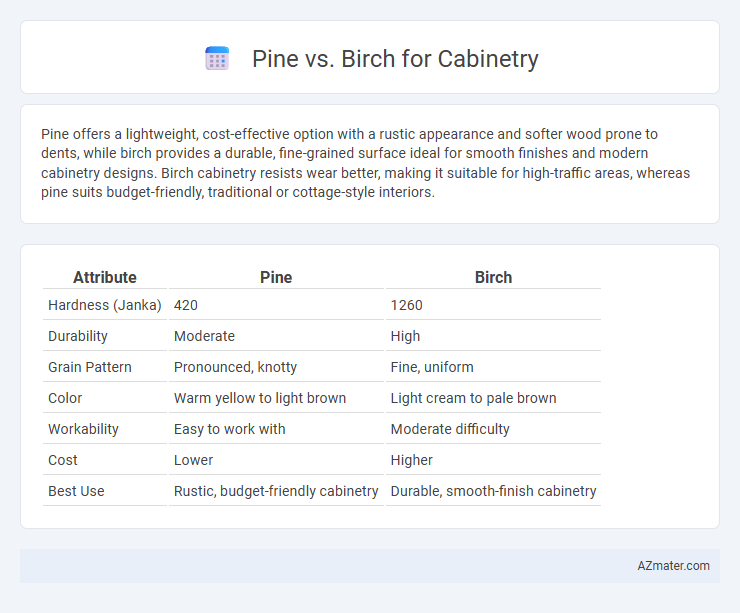Pine offers a lightweight, cost-effective option with a rustic appearance and softer wood prone to dents, while birch provides a durable, fine-grained surface ideal for smooth finishes and modern cabinetry designs. Birch cabinetry resists wear better, making it suitable for high-traffic areas, whereas pine suits budget-friendly, traditional or cottage-style interiors.
Table of Comparison
| Attribute | Pine | Birch |
|---|---|---|
| Hardness (Janka) | 420 | 1260 |
| Durability | Moderate | High |
| Grain Pattern | Pronounced, knotty | Fine, uniform |
| Color | Warm yellow to light brown | Light cream to pale brown |
| Workability | Easy to work with | Moderate difficulty |
| Cost | Lower | Higher |
| Best Use | Rustic, budget-friendly cabinetry | Durable, smooth-finish cabinetry |
Introduction to Pine and Birch in Cabinetry
Pine and birch are popular wood choices for cabinetry due to their durability and aesthetic appeal. Pine features a softwood profile with distinctive knots and a warm, rustic appearance, making it ideal for traditional and farmhouse-style kitchens. Birch, a hardwood, offers a smooth, fine grain and light color that suits modern and contemporary cabinetry designs, providing strength and resistance to wear.
Appearance and Grain Patterns
Pine cabinetry features a light yellow to pale brown color with prominent knots and a straight, uniform grain pattern that adds a rustic, natural charm to interiors. Birch offers a more refined appearance with a smooth, fine grain and a creamy white to light reddish-brown hue, making it ideal for modern or traditional cabinetry styles. The distinct grain and color variations between pine and birch allow homeowners to choose between a warm, country aesthetic or a sleek, polished look for their cabinetry.
Durability and Strength Comparison
Pine is a softwood known for its lightweight and affordability but is less durable and prone to dents and scratches compared to birch. Birch, a hardwood, offers superior strength, hardness, and resistance to wear, making it ideal for high-traffic cabinetry. Choosing birch ensures longer-lasting cabinets with better structural integrity, while pine suits budget-friendly, lower-usage areas.
Cost Differences
Pine cabinetry typically offers a lower cost compared to birch due to its faster growth rate and abundant availability, making it an economical choice for budget-conscious homeowners. Birch, being denser and more durable, commands a higher price point but provides greater resistance to dents and scratches, adding long-term value. Cost differences between pine and birch cabinets usually range from 20% to 40%, influenced by wood grade, finish options, and regional supply variations.
Workability and Ease of Finishing
Pine offers excellent workability due to its soft texture, allowing for easy cutting, shaping, and sanding, making it a preferred choice for DIY cabinetry projects. Birch, being a harder wood, provides a smoother surface that holds paint and stain well, delivering a durable and visually appealing finish. Both woods respond well to finishing techniques, but pine may require more careful sealing to prevent blotching during staining.
Suitability for Various Cabinet Styles
Pine offers a rustic, warm appearance ideal for traditional or country-style cabinetry, while birch provides a smooth, fine grain suitable for modern and contemporary designs. Pine's softness allows for easy shaping and distressing, enhancing craftsman or cottage aesthetics, whereas birch's hardness supports sleek, minimalistic finishes with durable surfaces. Both woods adapt well to staining and painting, allowing versatility across various cabinet styles depending on desired texture and durability.
Maintenance and Longevity
Pine cabinetry requires more frequent maintenance due to its softer wood, which is prone to dents and scratches, while birch offers greater durability with a harder surface that resists wear and tear. Birch cabinets typically have a longer lifespan, maintaining structural integrity and appearance over decades, making them a cost-effective choice for long-term investment. Proper sealing and finishing enhance both woods' longevity, but birch's natural resilience reduces the need for repeated repairs and refinishing.
Environmental Impact and Sustainability
Pine cabinetry often comes from faster-growing trees, making it a more renewable choice compared to birch, which grows slower and requires longer harvesting cycles. Birch wood cabins typically have a higher density, leading to longer-lasting furniture that can reduce waste over time, balancing sustainability concerns. Both woods are biodegradable and recyclable, but sourcing pine from certified sustainable forests significantly lowers its overall environmental footprint.
Popular Uses in Modern Cabinetry
Pine is frequently used in modern cabinetry for its affordability, lightweight nature, and distinct grain patterns that suit rustic and farmhouse styles. Birch offers a smooth, uniform grain and durability, making it ideal for sleek, contemporary cabinetry with a clean finish. Both woods are popular choices, with pine favored for character-rich designs and birch preferred for strength and a refined aesthetic in kitchen and bathroom cabinets.
Choosing Between Pine and Birch for Your Cabinets
Choosing between pine and birch for cabinetry depends on durability and aesthetics, with birch offering greater hardness and resistance to dents compared to the softer, more affordable pine. Birch features a smooth, fine grain that takes stains well, providing a versatile finish, while pine has prominent knots and a rustic appearance favored for country-style designs. Consider traffic and wear in the kitchen or bathroom, as birch holds up better under heavy use whereas pine may require more maintenance over time.

Infographic: Pine vs Birch for Cabinetry
 azmater.com
azmater.com